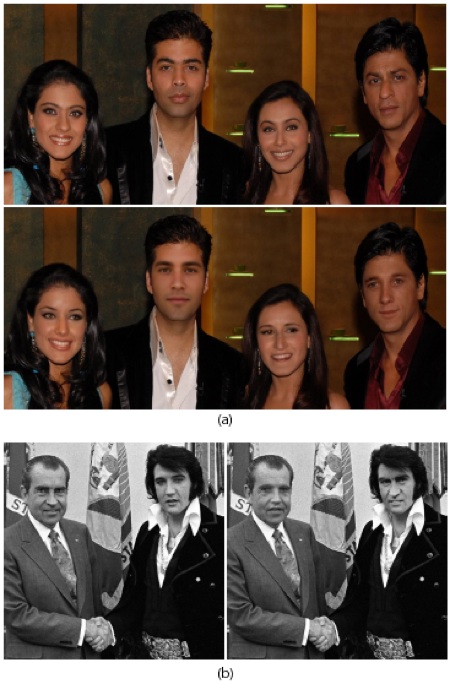Face Swapper Privacy
This is a cool hack. Face swapping software finds faces in a photograph and swaps the features in the target face from a library of faces. This can be used to “de-identify” faces that appear in public, such as the faces of people caught by the cameras of Google Street View. So instead of simply blurring the face, the software can substitute random features taken from say Flickr’s pool of faces. A mouth here, an eye there. Like this:

On the top (a) of the picture below, the original real faces. The row below show composite new faces. All generated automatically. As Michael Naimark suggested when he tipped me off to this development, “Swapping facial features can protect online privacy.” New Scientist makes a similar point: “the system could be used to obscure the faces of military personnel or eyewitnesses to crime.”

In the bottom set (b), the two faces are swapped. This can be useful for home use. Instead of swapping from a library of random strangers, the software can substitute faces taken from a set of images taken at about the same time. So if you are taking pictures at a birthday party of a group of restless children the software can swap their faces with versions of themselves with better or different expressions (smiles, no red eye) until you get a group picture you like (no one blinking).

The paper by Dmitri Bitouk and Neeraj Kumar of Columbia University is here (PDF). Here they state:
Systems such as Google Street View and EveryScape allow users to interactively navigate through panoramic images of public places created using thousands of photographs. Many of the images contain people who have not consented to be photographed, much less to have these photographs publicly viewable. Identity protection by obfuscating the face regions in the acquired photographs using blurring, pixelation, or simply covering them with black pixels is often undesirable as it diminishes the visual appeal of the image. Furthermore, many of these methods are currently applied manually, on an image-byimage basis. Since the number of images being captured is growing rapidly, any manual approach will soon be intractable. We believe that an attractive solution to the privacy problem is to remove the identities of people in photographs by automatically replacing their faces with ones from a collection of stock images.


